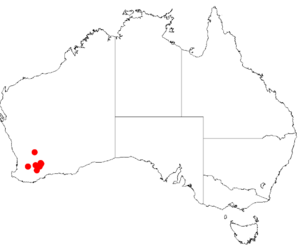Hyden wattle facts for kids
Quick facts for kids Hyden wattle |
|
|---|---|
| Conservation status | |
| Scientific classification | |
| Genus: |
Acacia
|
| Species: |
lanei
|
 |
|
| Acacia lanei occurrence data from Australasian Virtual Herbarium | |
The Hyden wattle, officially known as Acacia lanei, is a type of shrub. It belongs to the Acacia family, which is also known as wattles. This plant is special because it is found only in a specific part of south-western Australia. When a plant or animal is found only in one place, it is called endemic.
Contents
What Does the Hyden Wattle Look Like?
The Hyden wattle is a shrub that spreads out as it grows. It usually reaches a height of about 1.5 to 2.3 metres (5 to 8 ft), which is taller than most people. Its branches have sticky ribs and are covered in soft, white hairs.
Special Leaves: Phyllodes
Most Acacia plants, including the Hyden wattle, do not have regular leaves. Instead, they have something called phyllodes. Phyllodes are like flattened leaf stalks that do the job of leaves. They help the plant make food from sunlight.
The phyllodes of the Hyden wattle are always green. They grow upwards and are long and narrow, sometimes slightly curved. Each phyllode is about 4.5 to 6 cm (1.8 to 2.4 in) long and 3 to 5 mm (0.12 to 0.20 in) wide. They have many small veins running through them.
Flowers and Blooming Time
The Hyden wattle produces bright yellow flowers. You can usually see these flowers blooming between July and September.
Where Does the Hyden Wattle Grow?
The Hyden wattle is found in a region of Western Australia called the Wheatbelt. It likes to grow near creeks and drainage lines. You can find it in soils that are gravelly, clay-like, or a mix of both.
Its Home in Hyden
This wattle has a small home range, mostly around the town of Hyden. It often grows as part of Eucalypt woodlands. You might see it growing alongside trees like Eucalyptus loxophleba (York gum) or Eucalyptus salmonophloia (Salmon gum).
Uses and Protection
Farmers sometimes plant Hyden wattles to create windbreaks. These are rows of trees or shrubs that help protect fields from strong winds. An interesting fact is that livestock, like cows or sheep, usually do not eat the Hyden wattle. It is considered "unpalatable" to them, meaning they don't like its taste.


